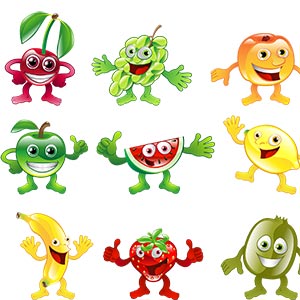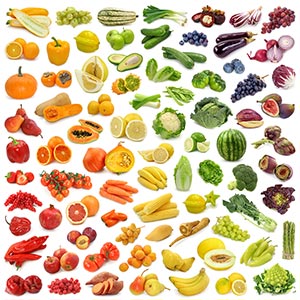Nevada Pre-K Standards: Revised and Approved: 2010. Povides the framework for curriculum and instruction in all of Nevada’s Pre-K classrooms. The content standards are used for planning curriculum, assessing growth and development, and for sharing important information with families.
- Mathematics & Science
- English Language Arts
- Social Emotional
- Creative Expression/Experiences
- Physical Development
Videos
Pre-K Standards:
English Language Arts: 1.K.4
Creative Expression/Visual Arts: 2.PK.4
Colorful Roll
Pre-K Standards:
Instructions
- Print colored dice cut out and fold into a cube.
- Give each child a turn rolling the dice
- The player should name a fruit or vegetable corresponding to the color it lands on.
Colorful Roll Dice Printable Version (PDF)
Exploring Food
Pre-K Standards:
Instructions
- Write each of the 5 senses on a piece of paper and place in a grab-bag.
- Introduce the new food.
- Take turns letting the children grab one of the 5 senses from the bag without looking.
- Depending on the sense they pick out, let the child explore
Examples:
- Touch: Feel the outside. Does the OUTSIDE of the kiwi FEEL smooth, hard, fuzzy, or soft?
- See: Open the food up. How does the INSIDE of the kiwi LOOK? What colors do you see?
- Smell: Sniff the food. How does the kiwi SMELL?
- Hear: Shake the food. Do you HEAR any sounds coming from the kiwi? What about when you eat it - does it make a sound? Can you think of a fruit that makes a sound when you bite it?
- Taste: Taste the food. Does the kiwi TASTE sweet or salty? Is it soft or crunchy?
- Allow the child who picks the taste card to taste the food first and describe to peers. Allow other to try food as well.
Exploring Food Printable Version (PDF)
Food Faces
Pre-K Standards:
Pre-K Standards:
Social Emotional: H1.PK.3, H3.PK.1
Physical Development: 1.PK.3
Introduce new foods using food faces. Create a positive experience by having children describe the colors they see, texture they feel , or the flavor they taste.
Instructions
- Pass out food face signs along with the new food item
- Have children try new food
- After trying the new food, let children hold up the sign whether they "like it!" or "might like it next time."
Food Faces Printable Version (PDF)
Food Relay
Pre-K Standards:
Pre-K Standards:
Life Science: L.PK.5
Physical Development/Health: 1.PK.1, 2.PK.1, 2.Pk.2, 3.PK.1, 3.PK.2, 4.PK2.1, 1.PK.3, 1.PK.8
Instructions
- Sit in a circle and teach children the importance of fruit and vegetables
- Print* out pictures of different fruit and vegetables (or use plastic models if available) and hang them/place them in different places around the room
- Divide children into two groups and have one group "build" a fruit salad and one a veggie salad.
- Children from each group will take turns choosing their own movements to get a picture for their salad. (Jump, crab walk, walk backwards, etc... to get picture)
Skills
- Light cardio
- Light muscle strengthening
Food Relay Printable Version (PDF)
Guess the Food
Pre-K Standards:
Pre-K Standards:
Mathematics & Science: L.PK.4, L.2.D.1
Instructions
- Collect a fruit or vegetable and conceal it in a non-see-through bag.
- Let the player touch what is in the bag and describe it.
- After everyone gets a turn allow players to guess which food group it belongs in and what it is.
Guess the Food Printable Version (PDF)
Mystery Tasting: Fruit or Vegetable?
Pre-K Standards:
Pre-K Standards:
Physical Development: 1.PK.1, 3.PK.1, 3.PK.2
Mathematics & Science: L.PK.4, L.2.D.1
Instructions
- Collect one item from each of the 5 food groups.
- Blindfold the player, allowing them to taste test each food item
- Let them guess which food group it belongs and what fruit or vegetable it is.
Mystery Tasting Printable Version (PDF)
Whoa & Go Yarn Race
Pre-K Standards:
Pre-K Standards:
Physical Development: 1.PK.1, 2.PK.2, 3.PK.1, 4.PK.1
Social/Economics: Ec10.PK.1 Emotional: 5.PK.1b
Creative Expression: 3.PK.3
Materials
- Piece of yarn 1 Yard long
- Piece of yarn 4 yards long
Instructions
- Cut one piece of yarn about 4 yards. Cut another piece 1 yard
- Have one kid eat a healthy, GO Snack and the other kid an unhealthy, WOAH Snack.
- Have the kid who ate the WOAH Snack take the 1-yard piece of yarn and walk out with it. (have someone hold the other end of the yarn)
- Explain that he/she was able to go this far on the energy they got from the unhealthy WOAH Snack.
- Have the kid who ate the GO Snack take the 4-yard piece of yarn and walk out with it next to the kid with the 1-yard yarn. (Again, have someone hold the other end of that piece of yarn too.)
- Explain that he/she was able to go a lot farther on the energy they got from the healthy GO Snack.
Skills
Whoa & Go Playing cards
- Mathematics & Science
- English Language Arts
- Social Emotional
- Creative Expression/Experiences
- Physical Development
Print Outs
 Grocery Shopping Bingo
Grocery Shopping Bingo
 Preschooler Shopping List
Preschooler Shopping List
 Whoa & Go Playing cards
Whoa & Go Playing cards


